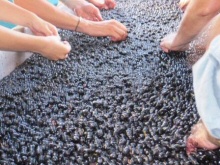|
 Pronunciation: gruh-NAHSH Pronunciation: gruh-NAHSH
Grenache noir is the world's most widely planted grape used to make red wine, sometimes made into a stand-alone varietal, frequently as a Rosé, but most often as a backbone of red blends.
 Used as a component in some Northern Rhône reds, nearly exclusively for Rhône rosés and as the primary component in nearly all Southern Rhône red blends, Grenache is probably most notable as the base varietal for Chateauneuf du Pape, Cotes du Rhône and Gigondas. In spite of its fame coming from French wines, Spain is most likely this grape's origin. Used as a component in some Northern Rhône reds, nearly exclusively for Rhône rosés and as the primary component in nearly all Southern Rhône red blends, Grenache is probably most notable as the base varietal for Chateauneuf du Pape, Cotes du Rhône and Gigondas. In spite of its fame coming from French wines, Spain is most likely this grape's origin.
Particularly important in the areas of the Languedoc and Rousillon, there are also variants with different colored berries: white Grenache Blanc, and pink Grenache Rose or Grenache Gris.
 In the New World, Australia has extensive plantings of Grenache and has been very successful making full-bodied Grenache-dominated red blends. Until surpassed by plantings of Merlot in the past decade, Grenache was the third most planted red variety in California after Zinfandel and Cabernet Sauvignon. In the New World, Australia has extensive plantings of Grenache and has been very successful making full-bodied Grenache-dominated red blends. Until surpassed by plantings of Merlot in the past decade, Grenache was the third most planted red variety in California after Zinfandel and Cabernet Sauvignon.
The grenache grape is relatively low in both pigment and malic acid, and oxidizes readily. Although some 100% varietal wines are produced from Grenache, particularly in Spain's Rioja and from some "old vines" plantings in California, it is mostly used to "fill out" red blends and soften harsher partners, such as Syrah and Carignan.
On its own, Grenache makes fleshy, heady, very fruity wines in their youth. They tend to age rapidly, showing tawny colors and prone to oxidation or maderization after only a relatively short time in bottle. The general character and mouthfeel of Grenache wines are more distinctive and identifyable than any particular aromas or flavors.
.
|